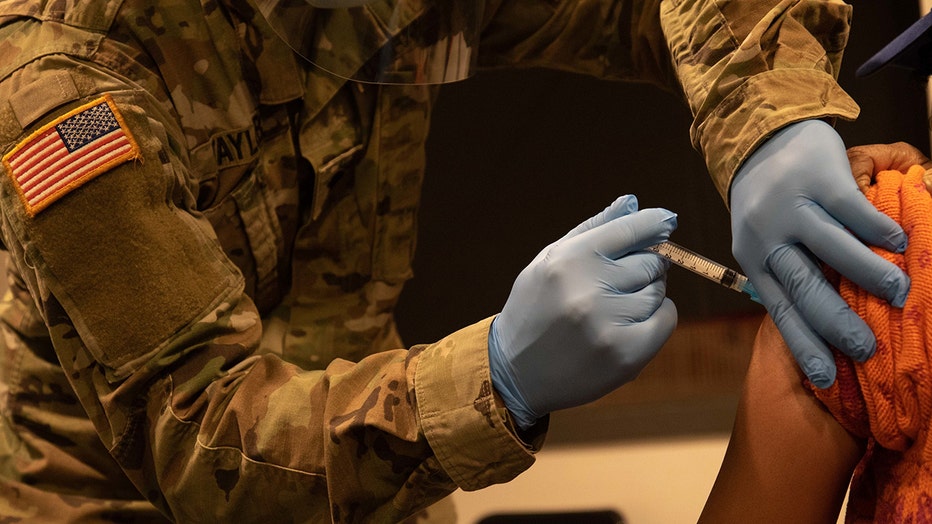What the CDC guidelines for fully vaccinated people mean for your family

Vaccination and visitation guidance
The CDC issued interim guidelines for activities that fully vaccinated people can safely do, such as visiting relatives.
NEW YORK - The U.S. Centers for Disease Control and Prevention released guidance on when fully vaccinated people can safely visit with others and start resuming normal life.
Two weeks after you're fully vaccinated, you can visit people at low risk for severe disease without wearing a mask and you don't have to quarantine after exposure, the CDC said in its new guidelines.
"I want to be able to return to everyday activities and engage with our friends, families and communities," Dr. Rochelle Walensky, the CDC director, said on Monday. "Today's action represents an important first step. It is not our final destination."
The CDC still recommends wearing a mask in public, avoiding crowds, and maintaining social distancing in homes with unvaccinated people.
And fully vaccinated grandparents can now visit healthy grandchildren who have not yet had the shot as long as those grandchildren are not part of a high-risk group.
CDC: Fully-vaccinated people can gather without masks, should still cover face in public
"If you are going to a get-together with people who are not fully vaccinated, you really focus on what's the risk to the unvaccinated people because you are going to be well protected," Dr. John Whyte, WebMD's chief medical officer, told FOX 5 NY.
Get breaking news alerts in the FOX 5 NY News app. Download for FREE!
More than 59 million Americans have gotten at least one vaccine dose so far, helping to drive down cases, deaths, and hospitalizations especially among the most vulnerable groups — senior citizens and those in long-term care facilities. About 60% of U.S. residents age 65 and older are already vaccinated.
"You know what that means? That's the group where you see 80% of deaths," Dr. Marc Siegel, a Fox News Medical contributor, said. "That's the group where you see most of the hospitalizations."
The CDC also said there appears to be a lower risk of fully vaccinated people transmitting the coronavirus to others than previously thought.
CDC GUIDANCE SUMMARY
This information is excerpted/adapted from CDC.gov.
Definition of 'Fully Vaccinated'
The CDC considers people to be fully vaccinated for COVID-19 two or more weeks after they have received the second dose in a two-dose vaccine series (Pfizer-BioNTech or Moderna) or two or more weeks after they have received a single-dose vaccine (Johnson & Johnson).
Visits Between Fully Vaccinated People
Indoor visits between fully vaccinated people who do not wear masks or keep physical distance from one another are likely low risk, according to the CDC. For example, if you are fully vaccinated, inviting other fully vaccinated friends to dinner inside your private residence is likely a low risk.
Visits Between Fully Vaccinated People and Unvaccinated People
Indoor visits between fully vaccinated people and unvaccinated people who do not wear masks or keep physical distance from one another are likely low risk for the vaccinated people, the CDC says. That is why the level of precautions you take is determined by the characteristics of the unvaccinated people because they remain unprotected against COVID-19.

U.S. Army Spc. Cody Taylor, a medic from Fort Campbell, Ky., gives a COVID-19 vaccine shot to a patient at First Baptist Church of Lincoln Gardens in Somerset, N.J., Feb. 17, 2021. (U.S. Army photo)
What Fully Vaccinated People Can Do
These CDC recommendations apply to non-healthcare settings.
- Visit with other fully vaccinated people indoors without wearing masks or physical distancing
- Visit with unvaccinated people from a single household who are at low risk for severe COVID-19 disease indoors without wearing masks or physical distancing
- Refrain from quarantine and testing following a known exposure if asymptomatic
What Fully Vaccinated People Should Continue to Do
- Take precautions in public like wearing a well-fitted mask and physical distancing
- Wear masks, practice physical distancing, and adhere to other prevention measures when visiting with unvaccinated people who are at increased risk for severe COVID-19 disease or who have an unvaccinated household member who is at increased risk for severe COVID-19 disease
- Wear masks, maintain physical distance, and practice other prevention measures when visiting with unvaccinated people from multiple households
- Avoid medium- and large-sized in-person gatherings
- Get tested if experiencing COVID-19 symptoms
- Follow guidance issued by individual employers

